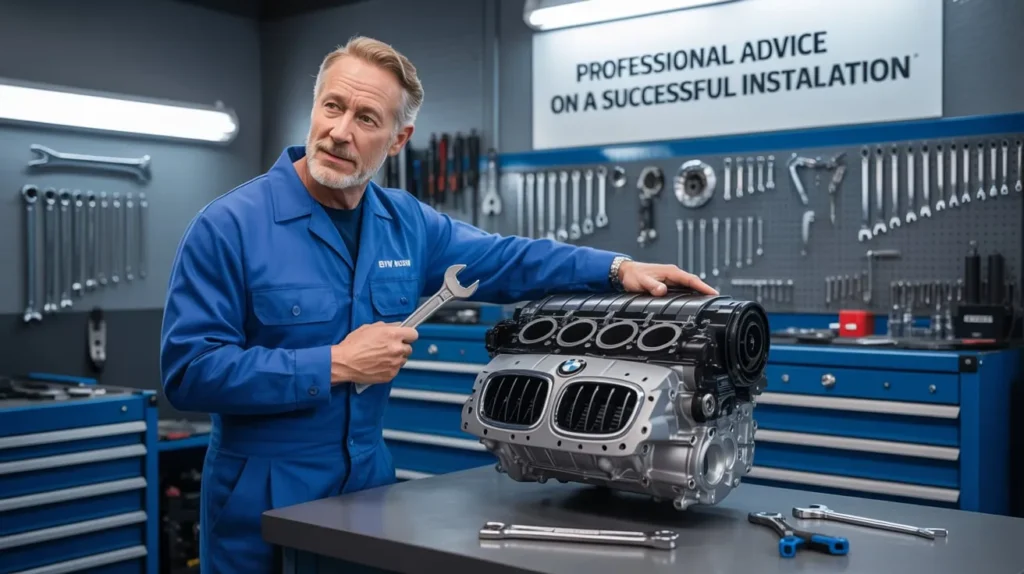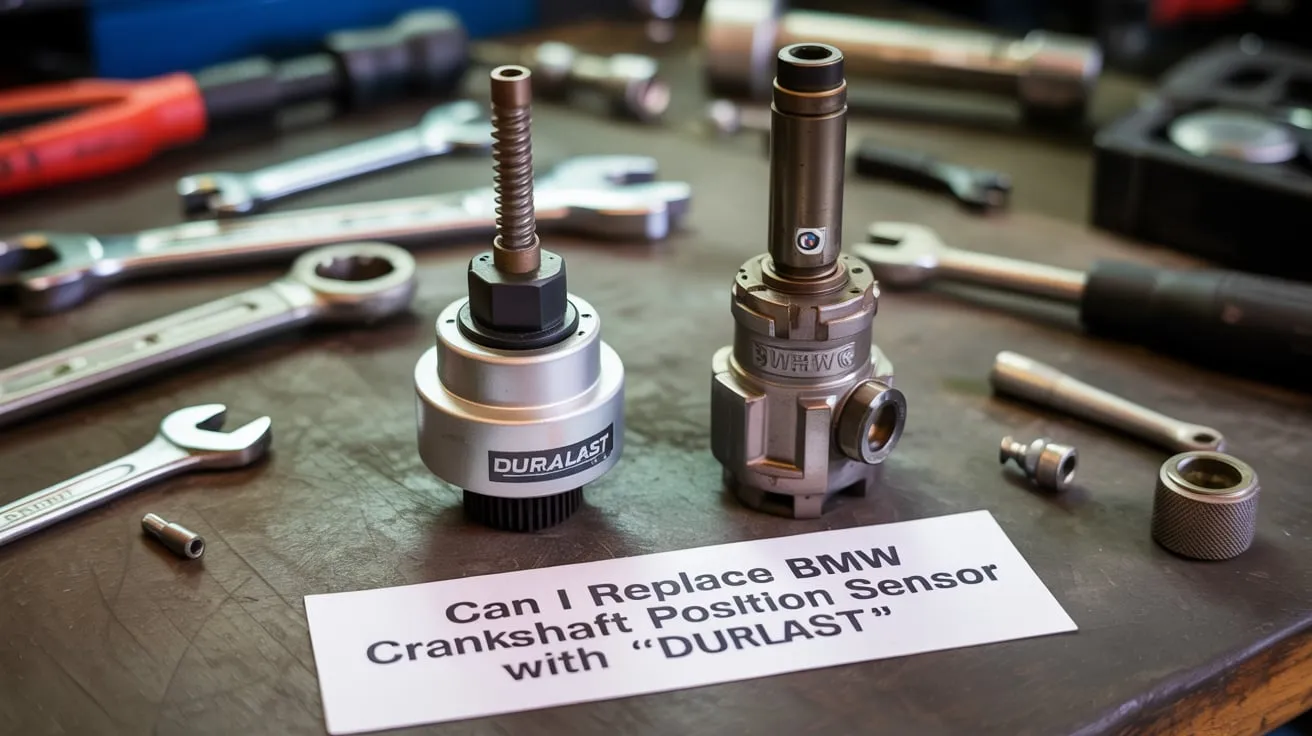The crankshaft position sensor is an important part of a BMW engine and is essential in the process of tracking the position and rotational speed of the crankshaft. This data is crucial to the engine control unit (ECU) to control fuel injection and ignition timing, to achieve the best performance and efficiency. The failure of a crankshaft position sensor may cause a lot of problems, such as low fuel consumption, harsh idling, and even engine stalling. Thus, it is crucial to know the importance of this sensor to any BMW owner who might be in need of a replacement.
In the case of replacing the crankshaft position sensor, car owners are usually confronted with the choice of either using OEM (Original Equipment Manufacturer) parts or aftermarket parts like Duralast. OEM parts are usually produced to the specifications of the car manufacturer and this can provide a feeling of reliability and assurance. Conversely, aftermarket parts such as Duralast can offer a cheaper alternative and purport to offer similar performance. This comparison begs a question: is it possible to have an aftermarket crankshaft position sensor that is as reliable and as good as the OEM one?
In this article, we are going to explore this dilemma, discussing the different aspects of replacing a BMW crankshaft position sensor with emphasis on the advantages and disadvantages of using Duralast. We will look at customer feedback, professional suggestions, and the general work of aftermarket sensors versus OEM. This discussion will help one make an informed choice by collecting the knowledge and personal experiences of mechanics and car owners, who have already had to replace their sensors.
Crankshaft Position Sensor Explained
Crankshaft position sensor (CKP) is a key element in the performance of a BMW engine and is vital in the tracking of the crankshaft position and rotational speed. This data is crucial in the best engine timing since it has a direct effect on ignition and fuel injection timing. The CKP sends real-time data to the engine control module (ECM) to make sure that the engine is running efficiently, which is beneficial to throttle response, fuel efficiency, and overall power output.
Crankshaft position sensors used in BMW vehicles are of two main types, the magnetic inductive sensor and the Hall effect sensor. Magnetic inductive sensors produce a voltage signal when the crankshaft is rotating and Hall effect sensors work based on magnetic fields to generate a similar signal. Both of them are placed strategically close to the main pulley of the crankshaft, usually at the bottom of the engine block, where they can precisely sense the position and speed of the crankshaft.
The crankshaft position sensor is important not only in timing, but also in the diagnostic ability of the vehicle. A well-functioning CKP can help detect engine problems using onboard diagnostics, which can be repaired in time. On the other hand, a defective sensor may cause performance problems. The signs of a faulty crankshaft position sensor can be engine stalling, hard starting, and poor acceleration, which indicates the necessity to check the health of the sensor.
To make sure that the crankshaft position sensor of a BMW works properly, it is possible to incorporate high-quality replacement options, including Duralast ones. The choice of the crankshaft sensor is critical to the efficiency and performance of the engine since it directly affects the functionality of the vehicle. Proper inspection and timely replacement can eventually extend the life of the engine and improve driving experiences.

Aftermarket vs. OEM: The Discussion
In the case of replacing a crankshaft position sensor in a BMW, car owners are usually confronted with a major choice: should they use an Original Equipment Manufacturer (OEM) part or an aftermarket part like Duralast. The basic differences between these two kinds of components can help make a wise decision. OEM parts are manufactured by the original manufacturer of the car, and thus they are made to the specifications and quality standards of the automaker. Consequently, they tend to provide a greater degree of reliability and compatibility with particular BMW models.
Conversely, aftermarket components, such as those sold by Duralast, can be a more economical alternative. Such components are usually produced by other companies and may differ greatly in quality. Although certain aftermarket sensors are manufactured to be equal or better than OEM, others might not be as reliable. Consumers need to do research on the particular aftermarket brand because reputation and customer reviews can give them an idea of how reliable and long-lasting their products are.
The other factor is the warranty of each of the options. OEM parts usually have a full warranty period, which gives the buyer an extra assurance. On the other hand, the warranty of aftermarket parts may be very different and some may not be warrantied at all, which can pose a financial risk in case the part breaks down early. Automotive professionals tend to advise that in situations where reliability is a priority, such as with a crankshaft position sensor, it may be worth the extra initial outlay to purchase an OEM part.
In the end, the decision between aftermarket and OEM parts must be informed by an analysis of the following factors: budget, the unique requirements of the vehicle, and the readiness of the owner to make some compromises regarding such factors as warranty and reliability. A middle-ground might assist in finding the most appropriate solution to your BMW replacement requirements.
Testing Duralast Crankshaft Position Sensors
Most car owners resort to other brands such as Duralast when replacing a BMW crankshaft position sensor. Duralast has become known to offer various automotive parts, such as crankshaft position sensors, and in many cases at competitive prices. The quality of these sensors is important in vehicle performance and reliability. Duralast crankshaft position sensors are produced with a focus on original equipment specification and beyond. This quality orientation makes it compatible with different models of vehicles including BMW.
There are mixed experiences with user reviews of Duralast crankshaft position sensors. Most drivers have had successful installations and positive performance results following their installation. They like that these sensors are usually warrantied, which gives them an added insurance policy against possible defects. Nevertheless, some reports of product quality inconsistencies are present, with some users reporting premature failure or unpredictable sensor readings. These mixed reviews show the necessity to evaluate the needs of your particular vehicle and take into account the opinions of other BMW owners who have already replaced something similar.
The reputation of Duralast in the automotive community is considered to be reliable, particularly among people who want to optimize their vehicle at a low cost. It is important to mention that Duralast sensors may be a cost-effective option, but the potential customers are advised to stay informed about the most frequent problems. Other users have complained of compatibility issues with some BMW models, which may cause sensor failure. Specifically, it is important to make sure that you choose the right part according to the type of your engine and the year of its production to prevent any installation inconveniences or performance drawbacks.
Finally, Duralast crankshaft position sensors could be a good alternative to BMW owners who need to replace it, but it is necessary to conduct a thorough research and consider user feedback before making a purchase.
Replacement Step-by-Step Guide
Changing the crankshaft position sensor in your BMW may assist in keeping the engine in top shape. The following is a step-by-step guide on how to do it, what tools to use and safety considerations.
Tools Required:
Before you begin the replacement, you will need the following tools:
Socket wrench set
Torque wrench
Screwdriver set
Jack stands and vehicle jack
New crankshaft position sensor
Gloves and safety goggles
Safety Precautions:
Safety is of utmost importance when it comes to this procedure. Never leave the vehicle on a sloping surface with the ignition on. Wear safety goggles to cover your eyes against flying debris and gloves to cover your hands. Before crawling under the vehicle, ensure that the jack is well placed and that jack stands are in place in case you are using a jack.
Replacement Steps:
Disconnect Battery: First, disconnect the negative terminal of the battery to avoid electrical shorts.
Lift Vehicle: Jack up your BMW with the jack and support it with jack stands. Ensure that it is stable before going any further.
Find the Sensor: Find the location of the crankshaft position sensor, which is typically located close to the engine block, and often adjacent to the crankshaft pulley.
Disconnect the Old Sensor: With your socket wrench, disconnect the wiring harness and unscrew the old sensor and remove it.
Install New Sensor: Place the new crankshaft position sensor in the proper position and make sure that it fits properly with the mounting holes and secure it tightly.
Reconnect Wiring: Reconnect the wiring harness to the new sensor.
Reconnect Battery: After the installation is done, reconnect the negative terminal of the battery.
Test Engine: Start the car to make sure that the installation is successful and the sensor works properly.
By carefully following these steps, you should be able to successfully replace your BMW crankshaft position sensor, improving the performance of your car and your DIY capabilities.
Typical Problems with Sensor Replacement
When installing a new crankshaft position sensor, especially aftermarket ones such as Duralast, there are a few problems that are likely to occur that can have an impact on your vehicle performance. These are the possible issues that one should be aware of to have a successful installation and keep your engine efficient. The most common problem is improper installation. This may be due to a mismatch of the sensor or wrong torque requirements during the attachment of the sensor to the engine block. These errors may cause inaccurate sensor readings, which may cause erratic engine performance, reduced performance, or even engine failure to start.
The replacement of the crankshaft position sensor is important in troubleshooting any ongoing issues. In case the vehicle has symptoms like stalling, rough idling, or the check engine light comes on after installation, it is recommended to recheck the connections and the location of the sensor. Make sure that electrical connections are tight and not corroded. Also, when the sensor interface is not clean, the dirt or debris may affect its functioning, which leads to additional complications.
To prevent these typical problems in the future, it is worth considering purchasing high-quality replacement parts and strictly adhering to the instructions of the manufacturer. It is possible to learn about the reliability of reputable aftermarket brands such as Duralast by researching them and reading customer reviews. Moreover, it is also a good idea to keep all the tools in order and have a clean working area when installing something, which can prevent errors. Finally, it may be helpful to consult a professional mechanic in case you are inexperienced, since their experience will help you avoid expensive mistakes and ensure a smooth installation procedure.

Professional Advice on a Successful Installation
The replacement of the crankshaft position sensor in your BMW is a procedure that when properly executed can bring back the best performance of the engine. In order to have a successful installation, it is important to first collect all the tools and parts needed including the Duralast crankshaft position sensor. Before starting the replacement, you should refer to the service manual of your vehicle to get specific instructions that apply to your model.
After preparing all the materials, begin by disconnecting the vehicle battery to avoid any electrical shocks when installing. Carefully clear away any parts that block access to the crankshaft position sensor, e.g. the intake manifold or engine covers. Having a clean working area and keeping the parts that are removed will facilitate reassembling.
Install the new Duralast sensor correctly and make sure that electrical connections are made. The bad connections may cause performance problems, and therefore, make sure to check twice that all terminals are clean and not corroded. Apply electrical contact cleaner, as needed, to improve connectivity.
Once you have installed the crankshaft position sensor successfully, it is important to synchronize it with the computer system of the vehicle. This is usually done with the use of an OBD-II scanner, which may also be used to diagnose any possible problems after installation. The sensor functionality can be tested using the scanner to ensure that it is working within the specifications required.
Lastly, once the installation and testing are complete, reinstall any parts you may have removed previously and then reconnect the battery. This methodical process does not only assist in keeping the system intact but also makes sure that the engine of your BMW is ready to perform at its best. Following these professional recommendations will allow you to change the crankshaft position sensor without fear of problems, and with minimal risk of complications.
Frequently Asked Questions (FAQs)
1. Is it acceptable to use an aftermarket crankshaft position sensor like Duralast?
Yes, it is possible to use aftermarket sensors like Duralast. However, it is important to ensure that the part is at least as good as an OEM sensor to maintain reliability and performance.
2. What tools are required to replace a BMW crankshaft position sensor?
A basic tool kit is needed, including a socket set, screwdriver, and possibly a torque wrench. Depending on the model, certain adapters for the electrical connections may also be required. Using the right tools will not only speed up the replacement but also prevent damage to other components.
3. How can I diagnose a faulty crankshaft position sensor?
Symptoms of a failing crankshaft position sensor include unstable engine performance, difficulty starting the vehicle, or stalling during movement. You can also use a diagnostic scan tool to check for error codes related to the sensor, which can help confirm the issue.
4. Is professional installation recommended for replacing the crankshaft position sensor?
While DIY replacements are possible if you have adequate mechanical knowledge, it is advisable to seek professional assistance. Professional technicians have specialized tools and experience that can help ensure the installation is done correctly, preventing potential problems.
5. What are the risks of using non-OEM parts like Duralast?
Using non-OEM parts may lead to compatibility issues or reduced reliability over time. It’s important for vehicle owners to weigh these risks and consider their unique driving conditions and vehicle usage when deciding whether to opt for a Duralast crankshaft position sensor.
Conclusion
We have first discussed in this article the importance of the crankshaft position sensor in a BMW car, and how it works in detecting the position and rotational speed of the crankshaft. This data is critical to the engine management system to operate at its best and provide efficient operation and performance. Then we talked about the possibility of replacing it with a Duralast crankshaft position sensor. Duralast is a famous brand of affordable aftermarket auto parts, and it has numerous components that can fit a wide range of vehicles, including BMW.
Some of the benefits of choosing a Duralast sensor include its low cost, ease of availability and ease of installation that makes it affordable to the DIY enthusiast. Moreover, Duralast usually offers a limited warranty on its products, which may make the consumer feel secure when purchasing a product. Nevertheless, one should also take into consideration the possible drawbacks. Problems like quality control differences, compatibility problems, and the possibility of lower performance than OEM parts can occur. There is a risk of premature failure or poor performance of some users with aftermarket components.
Finally, when deciding whether to change a BMW crankshaft position sensor with a Duralast one, it is crucial to take these advantages and disadvantages into account. The decision should be made based on factors like personal budget, the model of the BMW, and personal preference between quality and cost. Investing in an original equipment manufacturer (OEM) part can be a good idea to those who want reliability and performance. On the other hand, when cost savings is the most important factor and the user is cognizant of the possible trade-offs, a Duralast crankshaft position sensor can still be a viable option.
Read more:

